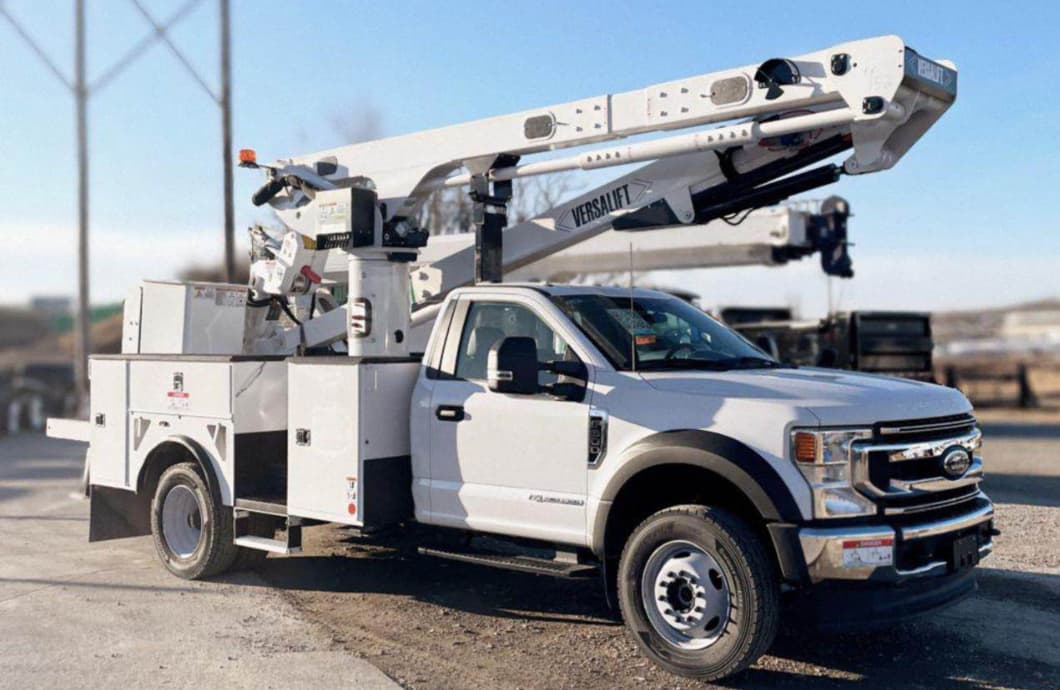
Table of Contents
Whether they're called bucket trucks, cherry-pickers, or aerial lift trucks, in the landscape of utility services vehicles, the bucket truck stands tall—pun only kinda intended.
However, not all bucket trucks are created (or treated) equally.
For prospective buyers, understanding key distinctions is helpful for making an informed decision about the type of bucket truck that will serve you best.
In this guide, we're going to break down some major points of consideration for your bucket truck buying journey—from types of bucket truck, which truck is best for which application, how much they cost, how to inspect a used bucket truck for sale, and more!
But before we get started...
For the most part, the terms "boom truck" and "bucket truck" are used interchangeably within the service truck industry. The terms "bucket" and "boom" refer to the main components of this style of truck—the "boom" being the extendable arm and the "bucket" being the secure platform at the end of the boom.
This being said, there are differences between what are commonly referred to as bucket trucks versus boom trucks.
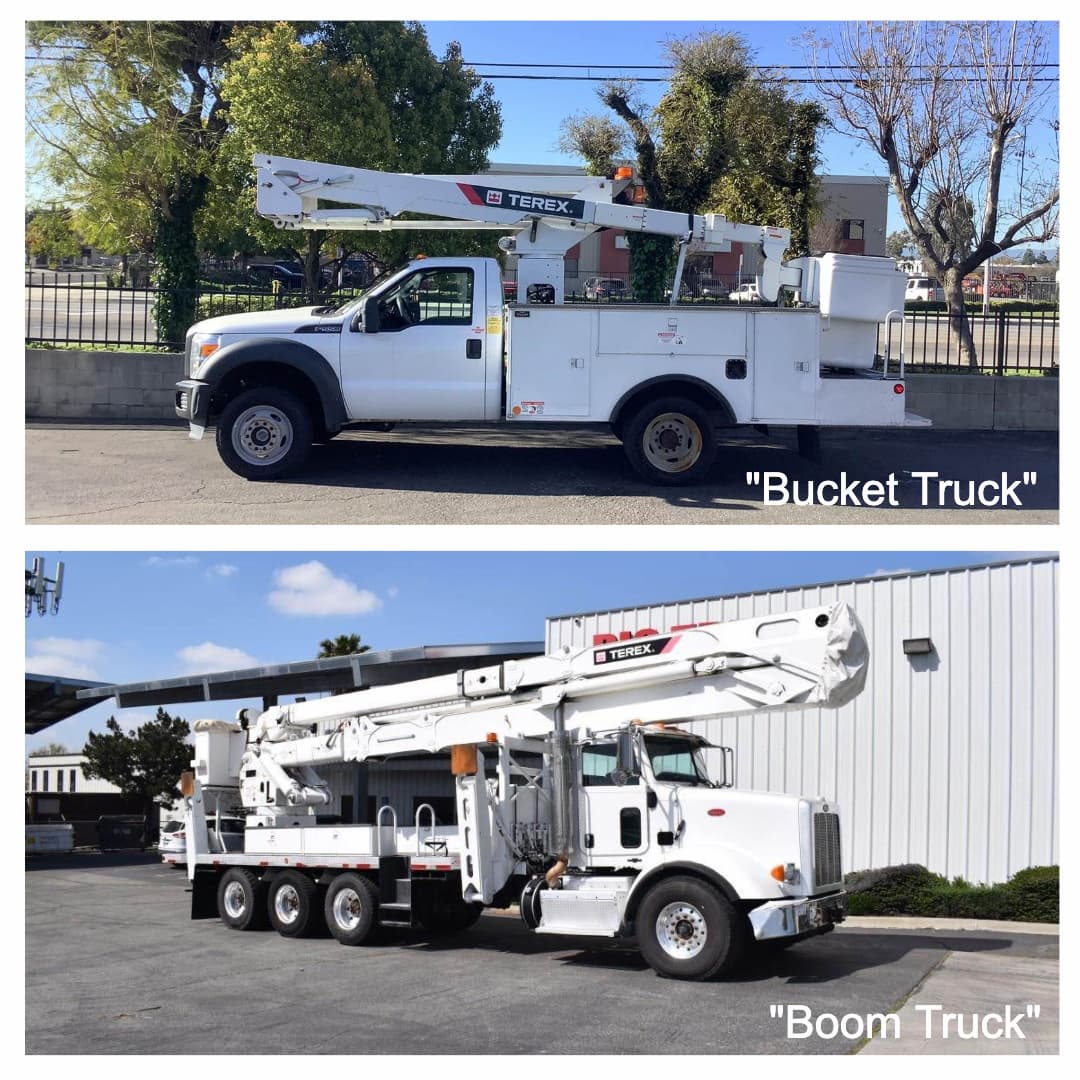
- Bucket trucks are generally smaller, with a single-person platform ideal for workers in electric utility maintenance, tree care, or other industries requiring solo tasks at height.
- In contrast, boom trucks have larger booms and platforms—accommodating multiple workers and material handling capabilities for heavy-duty applications such as construction and industrial projects. (See also "crane trucks" for similar models.)
For the purposes of this guide, we will be primarily using the term "bucket trucks" to refer to both styles of trucks.
Bucket Truck Versatility
.jpg)
Bucket trucks offer manned access to elevated work areas with greater reach and improved safety over traditional ladders.
From electrical line maintenance to tree trimming, the reach and flexibility of bucket trucks make them indispensable for numerous industries. Their ability to easily elevate workers to new heights simplifies high-reaching tasks while making them dramatically safer than alternative means of working at height (just imagine if all those cherry-picker jobs used manual ladders instead—yikes!).
Their evolution from simple cherry picker trucks in agriculture to complex machinery tailored to assist in completing intricate tasks in hard-to-reach areas spotlights their enhanced safety features.
Need to navigate crowded rail yards to access electric utility lines or elevate workers for building maintenance? No sweat! The unique application-specific design of many bucket trucks make them a valuable asset that allows for enhanced operational efficiency without sacrificing worker safety in various challenging environments.
Boom and Bucket Reach
With platforms that can soar from 35 to an impressive 125 feet (10-38 meters), bucket trucks are pivotal in offering flexible access to elevated areas.
And speaking of pivoting...
Many bucket trucks feature a 360-degree rotating arm—allowing precise positioning of the work platform for meticulous tasks and material handling capabilities. This enhanced reach eliminates the need for vehicle repositioning—saving considerable time and costs while enhancing productivity.
From electrical line maintenance to tree care and even unique scenarios like animal rescue, bucket trucks get it done!
Ok, you probably get the picture by now.
Let's help you buy the perfect bucket truck for your needs. But you're probably wondering...
Prices for new bucket trucks for sale can start at around $130,000.
Meanwhile, used bucket trucks for sale with similar capacities generally cost less at about $94,500.
For lighter-duty bucket trucks used mostly for routine facility maintenance, the price spectrum ranges from $37,000 to $140,000.
However, businesses in need of heavy-duty bucket or boom trucks for more demanding construction applications might see prices ranging from $84,000 to a hefty $370,000.
The Pros of Buying a New Bucket Truck
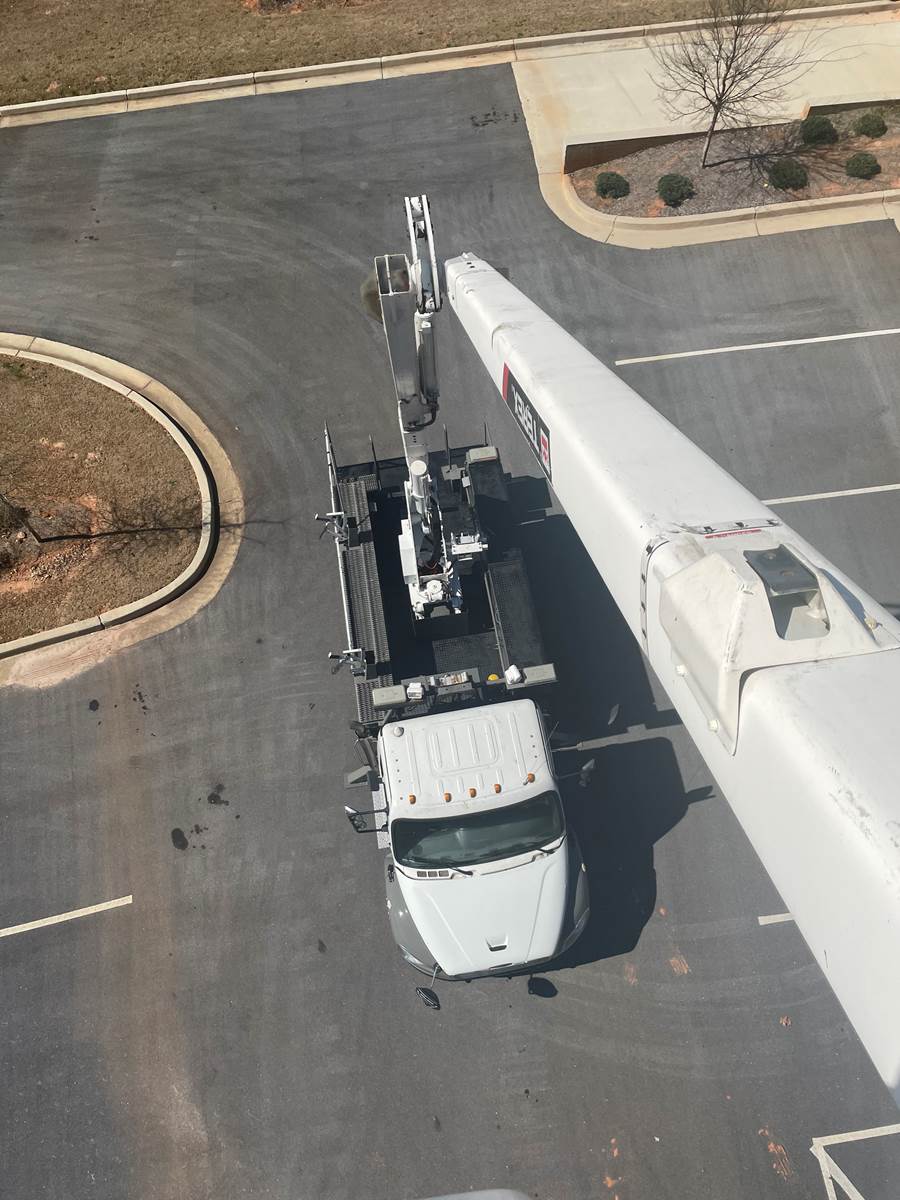
When deciding between a new or used bucket truck, opting for a new bucket truck for sale offers several key advantages.
- New bucket trucks come with comprehensive warranties—providing coverage for potential repairs and saving on maintenance costs.
- Newer models often feature advanced technology, such as improved hydraulic systems, better fuel efficiency, and enhanced safety features.
- Buying a new bucket truck usually includes the ability to customize the vehicle to one's specific needs—ensuring ideal working height, platform size, and additional features.
- Newer models generally require less maintenance, have fewer mechanical issues, and offer a longer operational life—which can offset the initial higher cost over time.
- New bucket smell! That's a thing, right?
The Pros of Buying a Used Bucket Truck
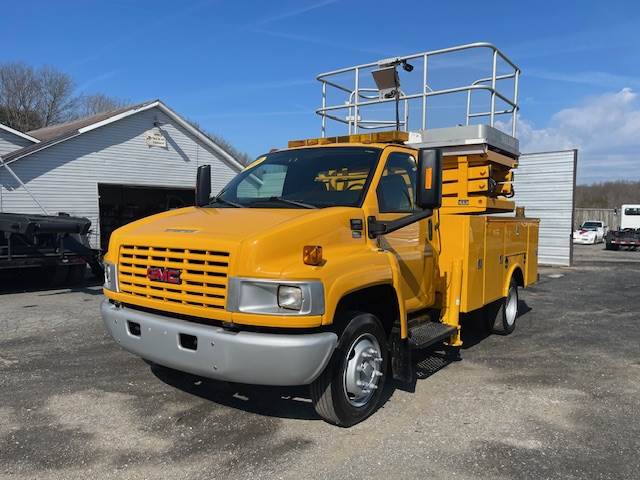
Scissor-style Aerial Lift Truck
Though buying a new truck can be nice, most folks will opt for used bucket trucks for sale. In addition to some steep savings, let's see what other benefits this decision can deliver.
- Purchasing a used bucket truck typically involves a lower initial investment (usually in the form of a down payment)—which can be helpful for businesses with tight budgets.
- Used bucket trucks have a proven track record, as they have already been in service and have demonstrated their reliability.
- There is a wider variety of used bucket trucks available on the market, giving buyers more options to choose from.
- Used bucket trucks can be a good choice for businesses that require a backup vehicle or have a temporary need, as they offer a more cost-effective solution.
- Buying used allows you to take advantage of the depreciation of the truck—making it a more affordable option.
Buying vs. Renting Bucket Trucks
Companies that regularly employ bucket trucks might find purchasing a truck more economical in the long run as opposed to renting—despite the higher upfront cost.
Still, renting a bucket truck is also an option worth considering, with daily, weekly, and monthly rates averaging at $600, $1,730, and $5,200, respectively.
The Steeper Cost for Insulated Booms for Bucket Trucks
Insulated bucket trucks, which provide additional safety for electrical work (covered more later in this piece), come at a premium—costing anywhere from 30% to 100% more than their non-insulated counterparts.
For new to recent models, this could mean a price bracket of $60,000 to $375,000. It’s worth noting that older insulated models might only feature insulation at one point, often the upper boom, so remember to keep such specific details in mind when shopping for a used bucket truck.
Also, for used models, carefully inspect the insulation on the boom and the bucket, ensuring there are no cracks or deterioration that could compromise safety.
Why Can Bucket Trucks Be So Expensive?
It's important to note that bucket trucks tend to be costly—partly due to limited manufacturers dominating the market. Frequent users of these vehicles often realize that acquisition makes more financial sense than constantly shelling out for rentals.
Working Height and Reach
One of the most important factors to consider when buying a bucket truck is the working height and reach. Determine the maximum height requirements needed for your specific job requirements—considering factors such as overhead power lines or building heights. Compare the specifications of ongoing needs with the rated reach of the boom to ensure accessibility to different work areas. This will also keep you from buying too much or too little truck for the jobs you anticipate performing.
Weight Capacity
The weight capacity of the bucket truck is another crucial factor. Evaluate the maximum weight that the truck platform can support to ensure it can handle the material handling capabilities required for your tasks. Consider the weight of equipment, any materials that need to be lifted, and yes, your personnel. (We resisted the urge to insert a dieting joke here.)
Platform Size and Configuration
The size of the platform is important for providing a comfortable workspace for workers. Evaluate the platform dimensions, considering the number of workers that will be on the platform at any given time, as well as the equipment or tools that need to be used.
Additionally, consider the configuration of the platform, such as if it can rotate or extend to reach specific angles or positions.
Outrigger or Stabilizer Considerations
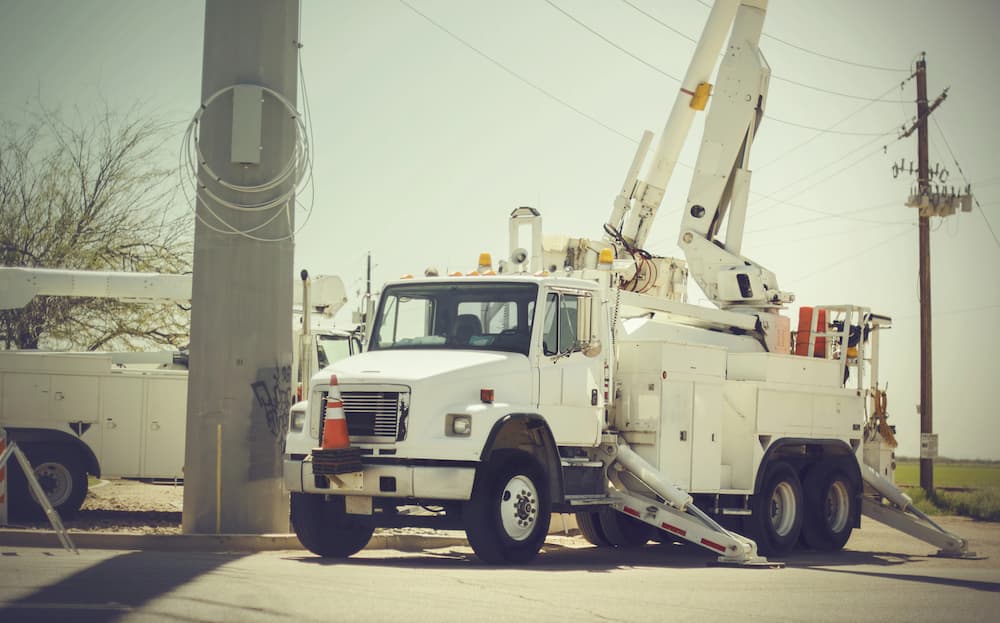
The supportive extendable legs that extend from a bucket truck are called outriggers or stabilizers. These hydraulic legs provide stability and balance to the vehicle when the boom is in use, ensuring safety during operation.
Safety Features
Bucket trucks come with various safety features to protect workers and ensure job site safety. Look for features such as bucket straps, fall protection systems, emergency lowering controls, outriggers, and safety interlocks. These features can help prevent accidents and injuries, so it's crucial to prioritize safety when making a purchase.
Maintenance and Service History
When shopping for used bucket trucks, asking for detailed maintenance records is should be one of the first questions. The maintenance history of a bucket truck you're thinking about buying can tell you a lot about its past—and the lack of one may tell you all you need to know. If you're shopping for a new bucket, ask the salesperson about the recommended maintenance schedule for that particular model and included warranty coverage.
Depending on your needs, its important to choose an elevated platform type more appropriate for your types of jobs. Bucket truck work platforms are categorized by the following lengths:
- Under 50 Feet
- 50-59 Feet
- Over 60 Feet
In addition to the vertical height, the side reach of a bucket truck elevated work truck is also an important detail to consider if you plan to not only reach up, but over obstacles.
Selecting Proper Boom Options
Insulated bucket trucks help protect workers from electrical shock while on the job. Insulated materials on bucket, boom, and platform prevent the transfer of electric current for workers interacting with live electrical components.
If you or your crew will need to perform service or maintenance on electrical components, opting for an insulated boom truck will be necessary.
Boom Insulation Ratings
More than simply insulated or not, there are varying levels of insulation ratings for bucket trucks to ensure proper protection from electric shock and damage to equipment.
- Category A: This category allows for use with barehands, as the boom will adequately protect workers. This rating also implies a test system built into the boom structure. It also allows for gloving if the proper covers are present.
- Category B: Category B buckets are also known a "gloving buckets"—meaning that this style of bucket have secondary protection and a test electrode. The main protection for this style of bucket will be via insulated tools, making it usable for gloving with additional covers.
- Category C: Category C carries with it much of the protection of a Category B model—for uses a secondary protection, but are limited to systems under 46 kV. Gloving is possible with the use of an additional cover.
- Category D: Bucket components with a D-rating category have no electrode system and do not need covers for gloving. Primary protection for these models is from insulated tools and work should be kept to under 46 kV.
- Category E: Lastly, category E protection requires keeping work to low-voltage systems. Their ratings can vary across models and should be noted on their provided nameplate.
Non-Insulated Bucket Trucks
If you're not planning on using your boom truck for electrical maintenance or around electrified components, non-insulated trucks can help to keep the price down.
Telescopic Boom Trucks
For tasks requiring bringing workers to higher positions, telescopic boom trucks may be the best fit. Telescopic booms are extend to some of the highest heights of any rated bucket trucks—allowing workers access to utility poles, elevated tree trimming, or higher building structures.
Non-Articulating Telescopic Boom Trucks
Say that three-times fast!
As a sub-category of telescopic truck, non-articulating telescopic bucket trucks have a straight extending boom. These models are known for their increased stability, though may be a bit less versatile due their non-articulating boom design. Though less versatile, this "limited" functionality can help keep the price down for buyers not in need of articulating booms.
Overcenter Boom Trucks
For the best of both worlds, overcenter bucket trucks can provide increased height as well as versatility. This model of bucket trucks are unique—with an increased side reach due to their stable over-center design. This stability and versatility come at a price, but for many are worth it!
Non-Overcenter Bucket Trucks
When side reach is less of a concern, non-overcenter bucket trucks can fit the bill. These trucks specialize in achieving great height, but due to a less central boom anchoring location, they are not as well suited for horizontal reach. Though this true, these trucks offer a simpler design that is easier to operate and maintain. These also tend to be less expensive than overcenter versions.
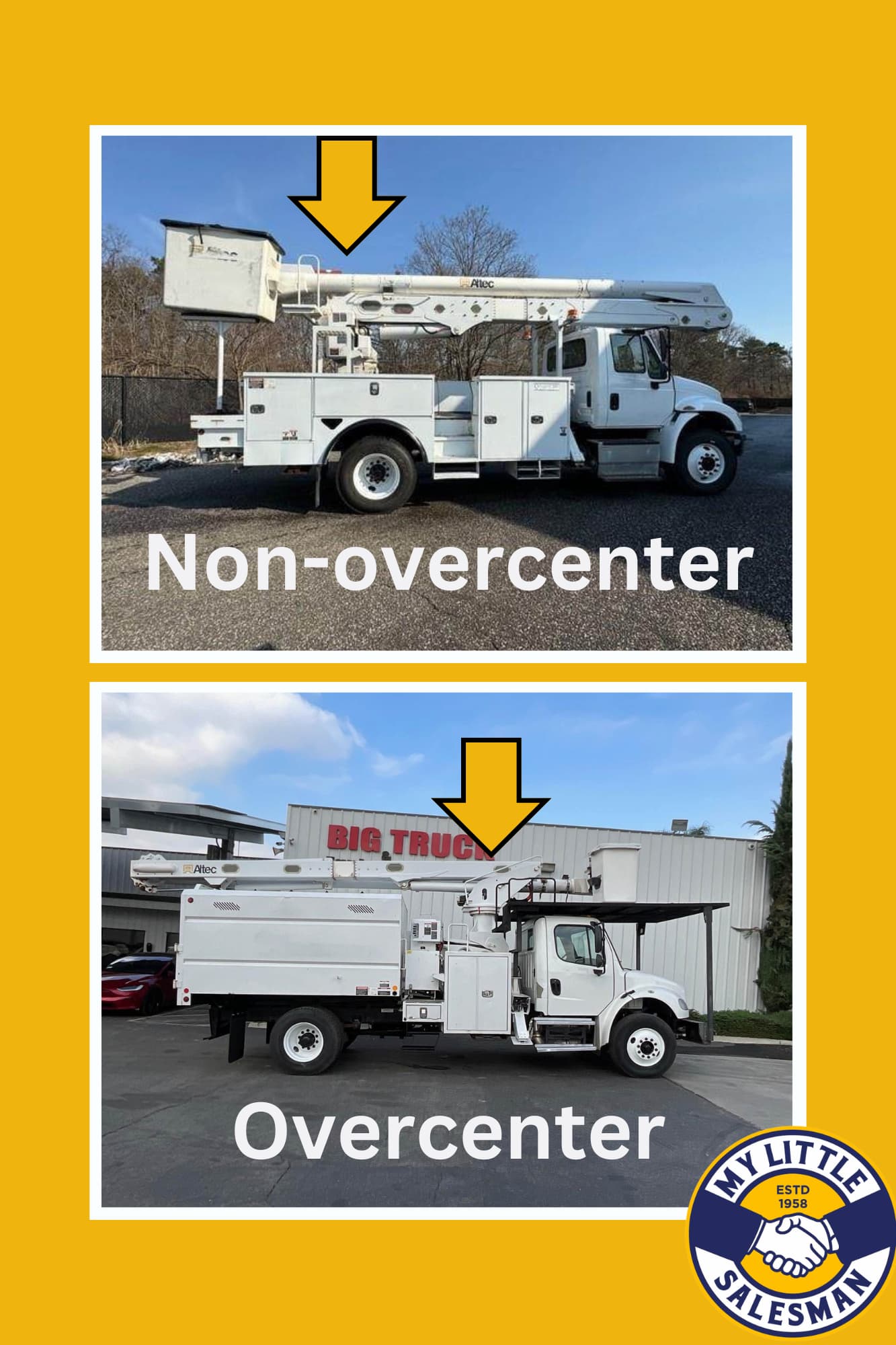
Driveline Configuration
Bucket trucks come an array of driveline configurations ranging from two-wheel drive, four-wheel drive, six-wheel drive, as well as tank-track style bucket trucks for harsh terrain. The larger the bucket truck, the more necessary complex driveline options become—with the 4-wheel-drive and 6-wheel-drive option best suited for heavy material handing requirements.
Cost of Maintenance
Initial bucket truck prices should also be weighed against the truck's the cost of ownership. Cheaper used bucket trucks can be appealing but may result in steeper maintenance costs.
To save yourself some headache down the line, it may be helpful to research the cost and availability of parts for certain cherry-picker models before shopping to manage maintenance cost expectations.
Consider the operational costs of these vehicles. Regular maintenance and inspection are non-negotiable for ensuring longevity and safety.
Before buying a bucket truck—especially used boom trucks—professional inspection is a must! Not only will professional inspections ensure that quality performance for years to come but will also help protect bucket truck operators from potential hazards—either from heights or electric shock.
Let's take a look at some specific components to inspect for any used bucket truck you're considering purchasing.
Exterior Truck Condition
Keep a keen eye out for rust, dents, corrosion, or other damage. Not only are these unsightly and diminish the value of the truck, but can speak to the overall treatment of the truck by past owners and operators.
Perhaps the most important aspect to inspect on a bucket truck is the boom. The boom should raise, extend, as well as lower and retract smoothly. Booms should also not contain any damage.
Other exterior damage to look out for include tire condition, fluid leaks, and the proper function of lights and signals.
Outrigger or Stabilizer Considerations To Examine
Do not overlook the condition of stabilizers and outriggers on any bucket truck you're considering—as these components are essential in keeping the truck stable and operators safe. They shouldn't show any corrosion, rust, dents, cracks, or other signs of unusual wear. Engage the outriggers—listening for odd sounds, watching for sticking, rattling, or leaking fluids. Also, make sure that the outriggers and stabilizers are rated for the clearances and types of terrain you will need the truck to be able to handle.
Engines and Transmissions
The engine the heart of any truck—and bucket trucks are no exception. Make sure it's functioning up to your standards!
Most boom or bucket trucks will be diesel—as these are those utilized the most by those needing durability, torque, and longevity. Make sure to test drive the bucket truck you're considering or have a professional do so—listening for peculiar sounds or sluggish operation. Be on the lookout for smoke upon startup and check all fluid levels.
While test driving, make sure the transmission is shifting smoothly—whether an automatic transmission or manual transmission. For manual transmissions, feel that the clutch is fully disengaged gears easily and that the gear box shifts smoothly. For automatic transmissions, see how quickly the gears shift under a slightly pressed gas pedal for smooth gear engaging. Lastly, give the transmission a visual inspection for fluid leaks and check transmission fluid levels.
Hybrid Bucket Trucks
More and more hybrid bucket trucks are appearing in the North American marketplace—popular for fuel efficiency and reduced emissions. The main area to inspect with hybrid bucket trucks that regular non-hybrid trucks don't possess will be the hybrid system—which includes a carefully synchronized electric motor, charging system, and batteries. These may also impact the function of aerial lift—the boom, hydraulics, and Power Take-Off (PTO) system. These should all be carefully inspected by a professional for optimal function.
Checking Out the Vehicle History
A look into who has owned and operated a bucket truck can give you a decent idea of how it was treated. And if the vehicle is history is missing years of records, this should also give pause to someone considering buying said truck.
Adequate bucket truck vehicle histories should include not only ownership, but use, maintenance, and repair. Proper checks of the vehicle VIN and serial numbers should be in line with the seller's description of the vehicle's past ownership and use.
Checking Bucket Truck Hydraulic Systems
The hydraulic system of a bucket truck is responsible for raising and lowering the boom safely and reliably. Carefully inspect all hydraulic system for signs of leaks, wear, and odd sounds or juttering movements during operation.
For hybrid models, ask the seller about the state of the electric motor—including its service schedule, battery age, and suggested maintenance schedule.
Inspecting Bucket Truck Safety Features
Due to its ability to hold technicians at raised heights to work on potentially dangerous electrical components, the safety of a bucket truck is paramount to its performance. For this reason, it is crucial to thorough inspect and test all safety components for proper use. Some of these include fall arrest systems, safety harness anchorage points, and emergency lowering mechanisms.
What Are Bucket Truck Deal Breakers?
While this guide should not be a replacement for professional inspection, it can help you identify certain red flags that can allow you to safely eliminate a bucket truck from your purchase considerations.
Bucket Truck Rust and Corrosion
Rust and corrosion can severely affect the long-term usability of a bucket truck. These issues often occur in vehicles used in harsh climates or that have seen heavy use. Regions with salty air or roads can be particularly brutal, leading to accelerated deterioration. Rust can erode the metal, compromising the structural integrity and posing a safety hazard for workers operating at high elevations.
During inspection, pay special attention to the boom and bucket areas—where integrity is paramount. If signs of advanced corrosion are evident, it's wise to consider another vehicle that's been managed better or is situated in a gentler environment.
Leaks and Fluid Contamination
Leaks are another critical concern when it comes to bucket truck performance and safety. Whether it's hydraulic fluid, oil, or other vital liquids, leaks can signify underlying issues with the vehicle’s mechanical systems. Fluid contamination as a result of leaks can damage the hydraulic system, restrict functionality, and even result in system failure when operating the boom or elevating the platform. A thorough inspection to identify leaks can save you from sudden operational failures and costly repairs.
Emissions Compliance
When purchasing a bucket or boom truck—especially a diesel engine bucket truck—it is crucial to consider Environmental Protection Agency (EPA) regulations. Ensuring compliance with emission standards is not only responsible but also prevents potential legal issues.
Don't Forget About Professional Inspections!
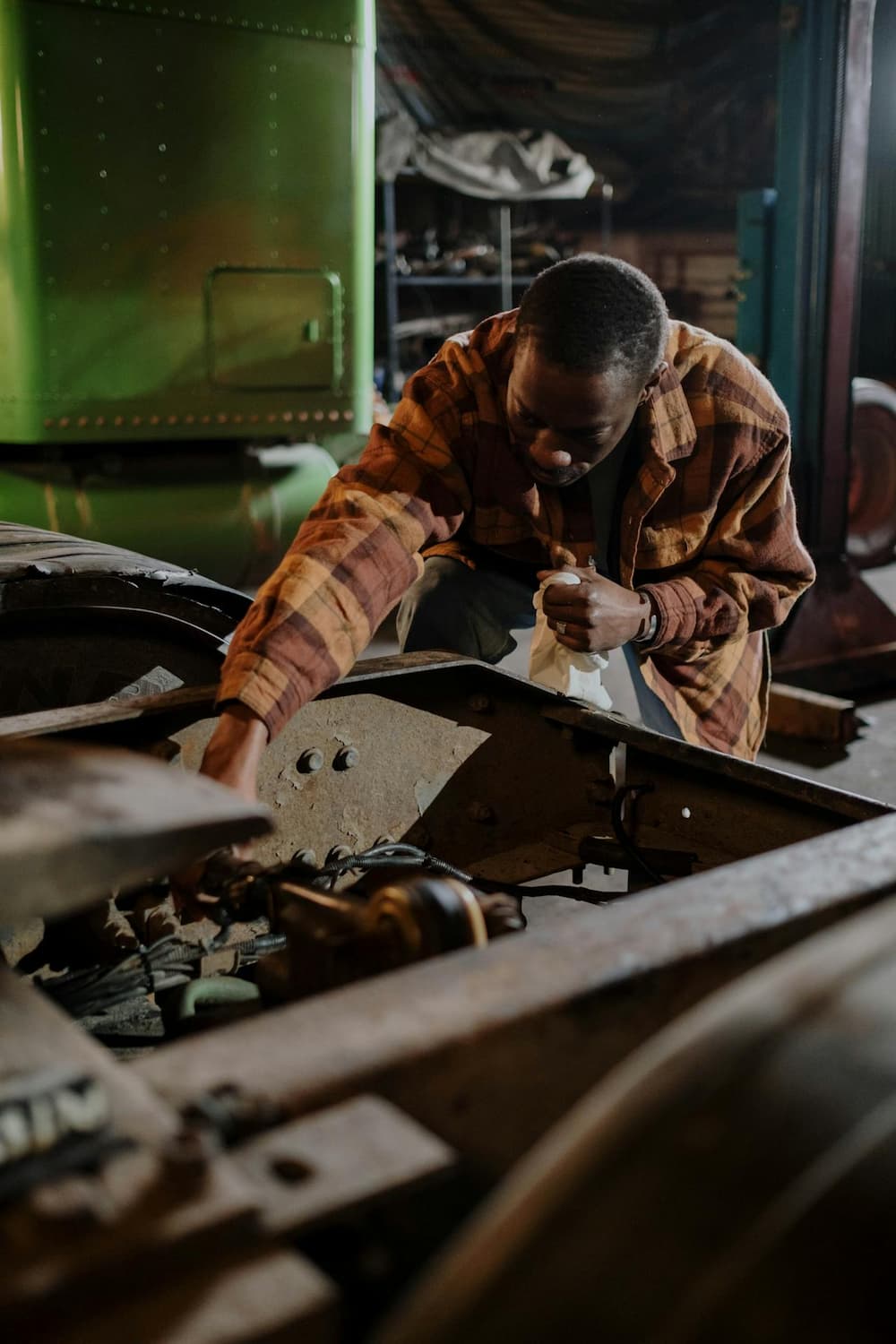
Even though an online list of red flags and dealer-breakers when buying a used bucket truck is a handy way to quickly remove trucks from consideration, any bucket trucks you're considering buying should be fully inspected by a specialized professional mechanic first. Though this may cost a few hundred dollars, it will be money well spent for your peace of mind.
Heck, this may even provide you with some negotiating power when agreeing upon a price depending on what the mechanic finds!
"Where can I find new and used bucket trucks for sale?"
When embarking on the purchase of a bucket truck, potential buyers have various avenues to explore.
- Bucket truck dealers can provide expertise and support as well as the newest models.
- Fleet companies are often looking to offload past fleet trucks at a discount, making them a great source for cost-effective used options.
- Private sellers may be a good source of used bucket trucks for sale to find a great deal, though special caution is urged to ensure the proper quality and safety of the vehicle.
- Online marketplaces provide a wide range of bucket truck styles and models from a variety of sources—including all of the above-mentioned options.
You're Now Ready to Find Your Next Bucket Truck for Sale
Equipped with this guide, you're ready to start shopping! Start pinpointing which model will serve you best, which will be the best value, and begin to narrow your field of bucket truck candidates that will move onto the final round of professional inspection before purchase.
You're also invited to find your winning bucket truck model with help from your friends at My Little Salesman. Since 1958, My Little Salesman has been connecting buyers with sellers of commercial trucks, heavy equipment, heavy tools, and accessories. Use the intuitive filtering tools through My Little Salesman's online marketplace to save a list of bucket truck models that fit the bill.